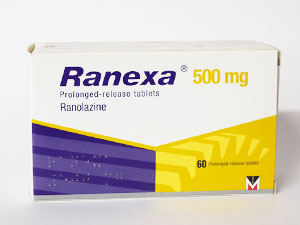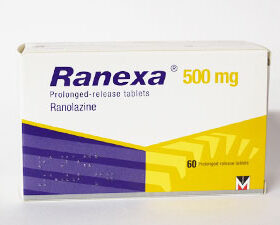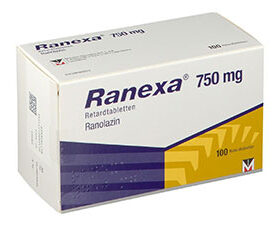- Your cart is empty
- Continue Shopping

Shop
Buy Ranexa Online

When it comes to Buy Ranexa Online for immediate shipment, our highly recommended online pharmacy is the greatest choice. FedEx offers a trustworthy and efficient delivery system that customers can rely on to make sure their goods arrives safely and on time.
Introduction to Ranexa
Ranexa (ranolazine) is a prescription medication used to treat chronic angina, a type of chest pain caused by reduced blood flow to the heart. It belongs to a class of drugs called antianginals.
Ranexa works by improving blood flow to the heart muscle and decreasing the heart’s workload. This helps increase the heart’s ability to pump blood and deliver oxygen throughout the body with less effort.
The key benefits of Ranexa include:
- Reducing the frequency of angina episodes
- Increasing exercise tolerance
- Providing an additional treatment option for chronic angina patients who are not fully responsive to other antianginal medications
Ranexa is not a substitute for existing angina treatments, but rather it is used as an add-on therapy for patients still experiencing angina symptoms despite optimal doses of other medications. It is taken orally, typically twice per day.
Medical Uses
Ranexa is a prescription medication primarily used for treating chronic angina, a type of chest pain caused by reduced blood flow to the heart. It can help reduce the frequency of angina episodes in people who already take other angina medications like beta blockers or calcium channel blockers but still experience symptoms.
Ranexa works by inhibiting the late sodium current in cardiomyocytes, which can help relax constricted blood vessels and increase blood flow to the heart. This reduces the workload on the heart and decreases oxygen demand. As a result, Ranexa can help delay or prevent angina attacks.
Mechanism of Action
A medication called ranexa (ranolazine) is used to treat persistent angina. It works by inhibiting the late sodium current in cardiac cells. This reduces cellular sodium and calcium overload that can occur in ischemic heart disease, which in turn reduces ischemia and angina.
Specifically, ranolazine blocks the persistent activation of the late sodium current in cardiomyocytes. This reduces the sodium-dependent calcium overload that leads to cardiac dysfunction and arrhythmias. Ranolazine is selective for blocking late INa over peak INa, which is responsible for the cardiac action potential. This allows ranolazine to reduce intracellular sodium and calcium concentrations without significantly impacting the other ion channels responsible for normal cardiac conduction.
By inhibiting late INa, ranolazine suppresses afterdepolarizations and decreases myocardial contractility. This improves diastolic tone and oxygen demand. Ranolazine’s actions ultimately serve to stabilize the cardiac membrane potential and suppress arrhythmias. The end result is an anti-ischemic and antianginal effect.
Dosage
Ranexa is typically prescribed at doses of 500 mg to 1000 mg, taken twice daily. It is available in tablet form in doses of 500 mg and 1000 mg.
The starting dose is usually 500 mg twice daily, which may be increased to 1000 mg twice daily as needed and tolerated. It is recommended to take Ranexa with meals as food increases absorption.
Ranexa should be taken every 12 hours and doses evenly spaced. It is important to take this medication regularly at the same times each day to maintain consistent levels in the bloodstream. If a dose is missed, the next dose should be taken at the usual scheduled time.
Side Effects
Ranexa is generally well tolerated, but some side effects may occur.
Common Side Effects
The most common side effects of Ranexa include:
- Dizziness
- Headache
- Constipation
- Nausea
- Fatigue
- Palpitations
These side effects are usually mild and tend to go away with continued treatment. Taking Ranexa with food can help reduce side effects like nausea.
Rare but Serious Side Effects
Though less frequent, more severe side effects are possible. Contact your doctor right away if you experience:
- Allergic reactions (swelling, hives, rash)
- Slow or irregular heart rate
- Liver problems (yellowing skin/eyes, dark urine, abdominal pain)
- Kidney problems (little or no urination)
- Low blood pressure
- Serious skin reactions (blistering, peeling, sores)
Ranexa may also lower blood glucose levels. Those taking diabetes medications should monitor blood sugar closely. Seek emergency care for very low blood sugar.
The Future of Ranexa
Ranexa continues to be an area of interest for researchers seeking new treatments for cardiovascular conditions. Here are some of the key areas being explored:
Ongoing Research
Several studies are underway evaluating Ranexa for new potential uses:
- Ranexa is being studied to see if it can reduce hospitalizations in patients with heart failure. Early research has shown promise that Ranexa may improve heart function in heart failure patients. Larger clinical trials are underway.
- Researchers are investigating if Ranexa can help treat atrial fibrillation, the most common heart rhythm disorder. Small studies have suggested Ranexa may help restore normal heart rhythm in some AFib patients. More research is needed.
- Combination drug therapies with Ranexa are also being researched. For example, pairing Ranexa with cell-protecting drugs to further reduce ischemia and improve outcomes after procedures like stent placement or bypass surgery.
Potential New Uses
In addition to the research mentioned above, scientists see potential for Ranexa to help treat other cardiovascular conditions:
- One area of interest is using Ranexa as part of post-heart attack treatment to reduce risk of a second heart attack and improve survival. More clinical trials are needed.
- There is interest in studying Ranexa for reducing ischemia and improving blood flow in peripheral arterial disease in the legs. Future research will determine if Ranexa may have benefits for PAD patients.
- Ranexa’s ability to restore electrical stability to the heart makes it a candidate for managing heart rhythm disorders beyond atrial fibrillation, such as ventricular tachycardia. Further study is warranted.
While more research is still needed, Ranexa shows promise as a potential therapy for multiple cardiovascular conditions beyond angina. Ongoing studies will shed more light on the future uses of this medication.



